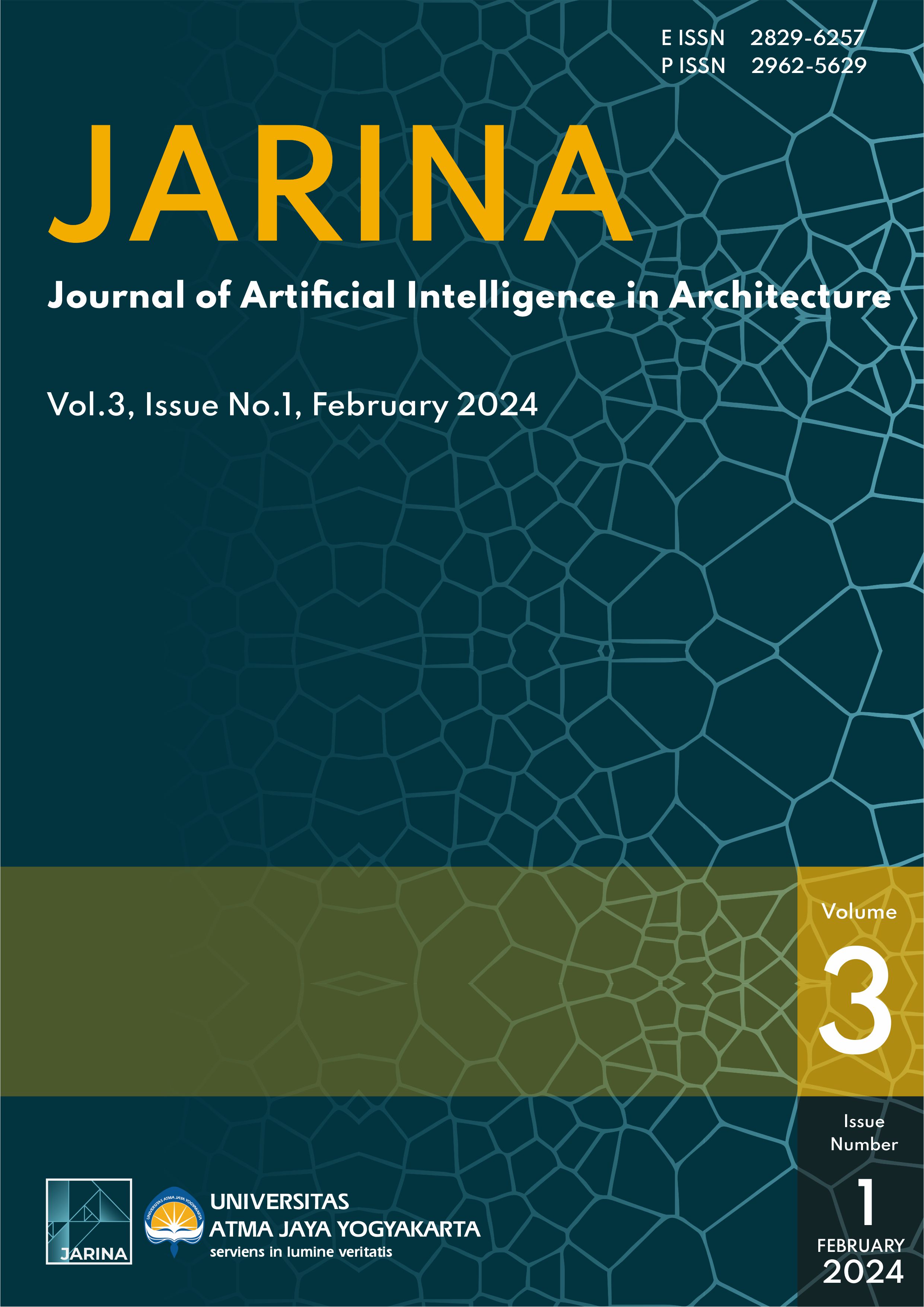Computational Methods and Artificial Intelligence in The Architectural Pre-Design Process (Case Study: House Design)
DOI:
https://doi.org/10.24002/jarina.v3i1.8431Keywords:
Architectural computing, Space Syntax , Artificial Intelligence, Design Method, Stable DiffusionAbstract
The current development of information technology infrastructure has positively impacted the ease with which people can carry out work activities physically and creatively. Artificial intelligence, which is currently starting to penetrate the world of visual design and architecture, is starting to develop from integrating design methods to methods of presenting or communicating architecture. In this study, aspects of artificial intelligence are used as a pre-design method, which is considered to help speed up decisions in design communication. The problem raised in this study is how optimal the involvement of computing and artificial intelligence is in providing pre-design considerations in the case of simple residential houses, especially in the analysis, space, and visual aspects. This study aims to obtain the methods and influence of computing and artificial intelligence in formulating pre-designs and generating understanding regarding the methods of their use. Several analysis tools are used for the spatial approach: the space syntax using DepthmapX software, solar analysis using the Shadedat plugin, and the visual shape of the building using Stable Diffusion. This research uses an experimental approach to obtain the desired design results. This study's findings explain that applying appropriate computational and artificial intelligence methods will produce an effective and efficient design process. With the correct sequence, it will have a measurable design process that can be assessed well.
References
F. Abdullah, “FENOMENA DIGITAL ERA REVOLUSI INDUSTRI 4.0,” 2019. [Online]. Available: http://www.carahsoft.com/community/the-digital-government-americans-deserve. (accessed Nov. 15, 2023).
M. Hegazy and A. Saleh, “Evolution of AI role in architectural design: between parametric exploration and machine hallucination,” MSA Engineering Journal, vol. 2, no. 2, pp. 262–288, Mar. 2023, doi: 10.21608/msaeng.2023.291873.
John W. Wade, Architecture, problems, and purposes : architectural design as a basic problem-solving process. New York: Wiley, 1977.
P. Kyratsis, “COMPUTATIONAL DESIGN AND DIGITAL MANUFACTURING APPLICATIONS,” 2020. (Accessed: Nov. 8, 2023)
A. Effendi and Yantri Komala Dewi, “Analisis Bibliometrik Perancangan Arsitektur Dengan Kecerdasan Buatan,” SARGA: Journal of Architecture and Urbanism, vol. 17, no. 1, pp. 48–63, Jan. 2023, doi: 10.56444/sarga.v17i1.219. (Accessed: Nov. 8, 2023)
A. Kaplan and M. Haenlein, “Siri, Siri, in my hand: Who’s the fairest in the land? On the interpretations, illustrations, and implications of artificial intelligence,” Business Horizons, vol. 62, no. 1. Elsevier Ltd, pp. 15–25, Jan. 01, 2019. doi 10.1016/j.bushor.2018.08.004.
Russell. Stuart J. Peter Norvig, “Artificial intelligence a modern approach,” 2010.
C. Bartneck, C. Lütge, A. Wagner, and S. Welsh, “SPRINGER BRIEFS IN ETHICS.” [Online]. Available: http://www.springer.com/series/10184. (accessed Dec. 2, 2023)
D. Davis WeWork, “Evaluating Buildings with Computation and Machine Learning,” 2016.
S. Ida Smith and C. Lasch, Machine earning Integration for Adaptive building Envelopes 1 Responsive facade modules with distributed control actuation points. An Experimental Framework for Intelligent Adaptive Control,” 2016.
J. H. Bill Hillier, “The_Social_Logic_of_Space_B_Hillier_and,” 1982.
A. Turner, “Depthmap: A Program to Perform Visibility Graph Analysis *,” 2001.
A. Stöckl, “Evaluating a Synthetic Image Dataset Generated with Stable Diffusion,” Nov. 2022, [Online]. Available: http://arxiv.org/abs/2211.01777 (Accessed: Dec. 1, 2023)
L. Zhang, A. Rao, and M. Agrawala, “Adding Conditional Control to Text-to-Image Diffusion Models,” 2023. [Online]. Available: https://openaccess.thecvf.com/content/ICCV2023/papers/Zhang_Adding_Conditional_Control_to_Text-to-Image_Diffusion_Models_ICCV_2023_paper.pdf (Accessed: Dec. 22, 2023)
J. C. Jones, J. Wiley, N. Sons, and C. York, “Design Methods: seeds of human futures,” 1998.
Downloads
Published
How to Cite
Issue
Section
License
Copyright (c) 2024 Widi cahya Yudhanta, Irwan Yudha Hadinata

This work is licensed under a Creative Commons Attribution 4.0 International License.
Authors who publish with this journal agree to the following terms:
1.Authors retain copyright and grant the journal right of first publication with the work simultaneously licensed under a Creative Commons that allows others to share the work with an acknowledgement of the work's authorship and initial publication in this journal.
2.Authors are able to enter into separate, additional contractual arrangements for the non-exclusive distribution of the journal's published version of the work (e.g., post it to an institutional repository or publish it in a book), with an acknowledgement of its initial publication in this journal.
3.Authors are permitted and encouraged to post their work online (e.g., in institutional repositories or on their website) prior to and during the submission process, as it can lead to productive exchanges, as well as earlier and greater citation of published work (See The Effect of Open Access).

















